The Wheelchair Guide
Your Wheelchair and Mobility Scooter Resource
Wheelchair Lifts, The Inexpensive Elevator Alternative
March 16th, 2010
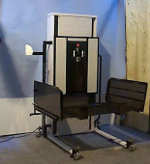 Wheelchairs are a powerful tool used to help those who have difficulty walking or getting around. There are many types of wheelchairs, including sports wheelchairs, manual wheelchairs, and electric wheelchairs. While incredibly useful, one common problem among wheelchair users is accessing areas that have staircases. One option to increase accessibility is to use a vertical platform lift.
Wheelchairs are a powerful tool used to help those who have difficulty walking or getting around. There are many types of wheelchairs, including sports wheelchairs, manual wheelchairs, and electric wheelchairs. While incredibly useful, one common problem among wheelchair users is accessing areas that have staircases. One option to increase accessibility is to use a vertical platform lift.
Vertical platform lifts are basically small elevators, but unlike a regular elevator, the unit is entirely self contained. Vertical platform lifts, which are also called porch lifts and wheelchair lifts, are placed next to the landing of a staircase and raise vertically to the top of the landing. Depending on the model, some porch lifts can raise up to 12 feet, which is rather high for a front porch.
Vertical platform lifts are similar to stair lifts, in that they are designed to be used by those who have difficulty using the stairs. However, unlike a stair lift, which only provides a chair or small platform to stand on, it is possible to drive a wheelchair directly onto the vertical platform lift. As a result, they can be used with manual wheelchairs, electric wheelchairs, and even mobility scooters, with most supporting over 500 pounds of weight.
Installing a wheelchair lift is usually very easy, but it requires a sturdy base that is capable of not only supporting the weight of the wheelchair lift, but also the people using it. The base should be made out of concrete or wood and it is very important to consider drainage as well. Proper drainage will prevent water from pooling up under the wheelchair lift, as well as keeping the area around it free from mud or pooled water. It is also important to consider roof water runoff, so it is important to have gutters installed above the wheelchair lift if it is to be installed under an overhang. Also, care should be taken to remove any limbs that may fall on the wheelchair lift during a storm.
Aside from a sturdy base, the only main requirement is that there is enough room next to the landing to install the wheelchair lift. This is because the platform of the wheelchair lift moves vertically from the ground to the landing and back down again, so it must be able to be placed next to the staircases landing. As a result, wheelchair lifts will often not work on interior staircases. In this case, a special platform stair lift is used, which uses a platform attached to a metal track running the length of the staircase to transport the wheelchair user. However, the exception to this rule is in commercial settings, such as schools and churches, where it is often possible to install the wheelchair lift directly next to the staircase’s landing.
Wheelchair lifts offer a very easy and cost effective way of making the home more accessible to wheelchair users, but many people still prefer to use a ramp. The main advantage of a wheelchair ramp is that it is usually considerably less expensive than a wheelchair lift, especially if you build it out of wood.
A Look at Manual and Electric Wheelchairs
March 9th, 2010
The wheelchair is probably the most recognized type of mobility vehicle, with its invention being traced back over a thousand years. However, if you were to look at one of the wheelchairs used by people during the 1600′s and compare it to one of those used today, you would be hard pressed to find similarities, aside from both having wheels and their general function.
Manual Wheelchairs
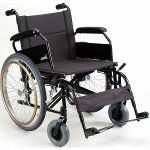 Today, wheelchairs are either manually powered or electric powered. Manual wheelchairs, or self-propelled wheelchairs, remain very popular and are often the least expensive option. Of course, there are exceptions to this rule, but generally a manual wheelchair costs about a third of what an electric wheelchair would.
Today, wheelchairs are either manually powered or electric powered. Manual wheelchairs, or self-propelled wheelchairs, remain very popular and are often the least expensive option. Of course, there are exceptions to this rule, but generally a manual wheelchair costs about a third of what an electric wheelchair would.
The general design of a manual wheelchair is based off of the 1920′s E&J Wheelchair Frame, which was a folding hollow-tubed wheelchair, designed to be easily transported. The basic design has not changed too much and the outline of the E&J wheelchair can still be seen in most modern wheelchair.
Most manual wheelchairs have a a large set of rear wheels, which can be turned by the person sitting in the wheelchair. A metal hand-rim extends from the rear wheel, providing a handhold for the user to grasp and spin the wheel, without having to touch the part that makes contact with the ground. The front wheels are usually much smaller and the front rigging of the wheelchair provides a footrest for the user, so their feet do not touch the ground.
The seat of a standard manual wheelchair is often made out of vinyl, which is looped around the metal tube framing of the wheelchair and sewn in place. However, more breathable fabrics are also available and are more common on sports wheelchairs. When not in use, the wheelchair can be folded up, making it much easier to transport.
While the majority of manual wheelchairs are self propelled, transport wheelchairs are also available, which are designed to be pushed from behind. Transport wheelchairs share a similar design, but the rear wheels are usually smaller and do not have handrims.
Electric Wheelchairs
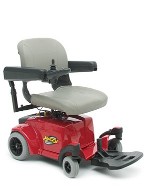 Electric wheelchairs are becoming much more common and offer the same basic functionality of a manual wheelchair, but the chair itself is powered by an electric motor, instead of the wheelchair user. The seat, which varies in size, but often resembles an office chair, is mounted atop a plastic base. The plastic base contains the electric motor and rechargeable battery that powers the wheelchair.
Electric wheelchairs are becoming much more common and offer the same basic functionality of a manual wheelchair, but the chair itself is powered by an electric motor, instead of the wheelchair user. The seat, which varies in size, but often resembles an office chair, is mounted atop a plastic base. The plastic base contains the electric motor and rechargeable battery that powers the wheelchair.
Like a manual wheelchair, electric wheelchairs provide a footrest, but the footrest is usually one piece of plastic, instead of the two individual footrests that are most common on a manual wheelchair. The standard control system for an electric wheelchair is a single joystick control that is mounted to the left or right armrest. The control system allows the wheelchair to be turned and moved by pushing on the joystick, as well as offering buttons to control the speed of the wheelchair. The range can vary depending on the model, as does the speed, but most quality electric wheelchairs can travel around 10 miles per charge and up to 4MPH.
Which is Better? Electric or Manual?
This is something that varies greatly by user and a lot of it comes down to personal preference. However, using a manual wheelchair can be quite strenuous, requiring a good deal of upper body strength, so this is often a factor. Cost also often plays a role, with many quality manual wheelchairs being available for under $500, while most electric wheelchairs cost over $2000.
Another factor to consider is where the wheelchair is going to be used and how often it will be used. A manual wheelchair may end up being easier to transport and better suited for indoor use, while for those who will be traveling across greater distances each day, an electric wheelchair might be a better choice.
Senior Mobility Scooters Explained
February 28th, 2010
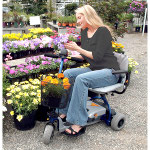 Wheelchairs are a powerful asset to those who are unable or have difficulty walking, but for seniors who are able to walk for short periods of time, the mobility scooter is often a better choice. Mobility scooters are similar to wheelchairs in functionality, but use a different design and typically cost less than an electric wheelchair.
Wheelchairs are a powerful asset to those who are unable or have difficulty walking, but for seniors who are able to walk for short periods of time, the mobility scooter is often a better choice. Mobility scooters are similar to wheelchairs in functionality, but use a different design and typically cost less than an electric wheelchair.
Mobility scooters, which are often called adult scooters, have a much longer base that an electric wheelchair does. The base, which is made out of molded plastic, has one set of wheels in the front and another in the back, although many are three wheeled, so only have one wheel in front. The user sits in a chair that is positioned more towards the rear of the scooter and a tiller, which is similar to a set of handlebars, extends from the front of the scooter and is used to control it.
The tiller usually allows the scooter to not only be turned, but also contain a key locking mechanism, speed controls, and is used to control any other accessories, such as horns and lighting. Many also come with a basket that is attached to the front of the scooter, although even those that do not can be fitted with an aftermarket basket.
Mobility scooters utilize rechargeable batteries, which mean unlike gasoline scooters, a mobility scooter can be used indoors and outdoors. The per-charge range varies by model, with most allowing for at least a 4 mile per-charge range.
Travel scooters, which are designed to be very lightweight, can be taken apart into several pieces, with the heaviest piece usually not weighing over 30 pounds. This way, the scooter can be taken apart and placed in the rear of a vehicle, without having to use a scooter carrier or lift. Of course, to reduce weight many of the comfort features are removed and travel scooters usually have a lower weight capacity and per charge range.
Heavy duty scooters, on the other hand, are almost the complete opposite of a travel scooter. They are designed with performance in mind and have a much higher weight capacity and can often travel over 20 miles on a single charge. With larger tires and higher ground clearance, as well as reinforced bumpers, heavyduty scooters are also have much better performance outdoors and across rugged terrain. However, since they are so much larger in size, it is necessary to use a vehicle scooter lift to transport them. Even though they, like most mobility scooters, can be disassembled into several pieces, the individual pieces are much heavier than those of travel scooters.
The Adult Scooter is often a lower cost alternative to the electric wheelchair. However, due to its design, a mobility scooter can not be driven directly up to a table or desk in the same way a wheelchair can. As a result, most people who use mobility scooters can walk for short periods of time. There are many wheelchair users though that invest in a heavy duty scooter for outdoor use, as they can be driven almost anywhere.
Avoiding the High Pressure Sales Pitch: Learning About Mobility Scooters
February 20th, 2010
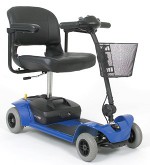 Many people have seen the commercials for Rascal Scooters or any of the other types of mobility scooters and thought to themselves, wow that would really make my life easier. Mobility scooters are powerful tools for the elderly, as well as others who have difficulty walking for longer distances. However, if you actually call up their number, you are very likely to end up talking to a high pressure salesman, who is payed off of commission and therefore motivated to make a sale, much more than they are to help you find the right mobility scooter.
Many people have seen the commercials for Rascal Scooters or any of the other types of mobility scooters and thought to themselves, wow that would really make my life easier. Mobility scooters are powerful tools for the elderly, as well as others who have difficulty walking for longer distances. However, if you actually call up their number, you are very likely to end up talking to a high pressure salesman, who is payed off of commission and therefore motivated to make a sale, much more than they are to help you find the right mobility scooter.
So, rather than simply call up these companies, it is a good idea to learn about mobility scooters first and explore all of your options. That way, rather than leading you to a sale, you can lead the salesman to what you really need.
What is a Mobility Scooter?
The mobility scooter is a special type of home medical equipment that provide a motorized platform to move its user from one area to another. That is to say, they are a type of mobility vehicle, similar in function to a wheelchair, but using a much different design.
Mobility scooters are battery powered, running off of at least one rechargeable battery. Some mobility scooters can travel over 20 miles on a single charge, but when looking at a medical supply companies website, it is important to keep in mind there are a lot of factors that can affect a mobility scooters range. For example, a heavier rider will see a shorted range than a lighter one. Along the same lines, if the mobility scooter is driven up hill, the battery will wear out much more rapidly than if it is driven across flat ground.
Other factors that affect range are the age of the battery, with it wearing down over time and usually needing replacement every 12 to 18 months, as well as how the battery is charged. Like all electronics, regularly and correctly recharging a battery is very important, with the first few months being the most important. So, make sure to follow the manufacturers instructions for recharging your scooter to ensure the best possible per-charge range.
What Kinds of Mobility Scooters Are Available?
There are many different types of mobility scooters, but they can basically be broken down into heavy duty scooters, travel scooters, and regular scooters.
Heavy Duty Mobility Scooters are arguably the most fun to drive, because they have the highest weight capacity and are designed to be driven almost anywhere, including over off-road terrain. They have a reinforced frame, larger tires, higher top speeds, a larger per-charge range, and higher ground clearance. However, heavy duty scooters are not just designed for outdoor use, but have a much higher weight capacity. One downside to a heavy duty scooter, however, is their size, which makes them impractical for use in some homes.
Travel Scooters are essentially the polar opposite of a heavy duty scooter. Where the heavy duty scooter is designed to be as powerful and strong as possible, the travel scooter is designed to be as light as possible. As a result, they are no where near as sturdy and lack a number of features common on other types of scooters, but they can be taken apart easily and placed in the trunk of a car. The main idea behind a travel scooter is that when it is taken apart, the individual pieces are light enough that they can be moved by the user without the need for a scooter lift. As a result, everything, from the frame to the seat, is minimized to reduce weight.
Regular scooters form the middle ground, falling in between travel scooters and heavy duty scooters. They have many more features than a travel scooter, but are not as easy to transport, sometimes requiring a vehicle scooter lift. However, they are much more comfortable than a travel scooter and usually have a higher per-charge range, yet unlike a heavy duty scooter, they are usually small enough to work in all homes.
What Mobility Scooter Manufacturer Should I Choose?
There are quite a few different manufactures of mobility scooters, so it can be confusing knowing which one to select. Inevitably two names stick out, however, as Golden Technologies and Pride Mobility are both known for their home medical equipment, which includes not only mobility scooters, but also lift chairs, adjustable beds, and electric wheelchairs. ShopRider is another popular manufacturer, which offers a less expensive option.
Since there are so many manufacturers of adult scooters, it is important to compare the different electric scooters available to find the one that will best fit your needs and your budget. When comparing different scooters, make sure to look at the warranty offered, as well as how well known the brand is. For example, it is possible to get some really cheap no-name mobility scooters from overseas, but chances are, they won’t last very long and will be covered by a much less inclusive warranty that requires expensive shipping if something breaks.
What Are Mobility Scooters?
February 9th, 2010
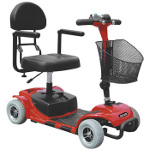 Moving around is often quite difficult for the elderly, especially among seniors who have arthritis. Since using a wheelchair can be quite strenuous, it is often not a good choice for seniors, especially those who intend to travel away from the home.
Moving around is often quite difficult for the elderly, especially among seniors who have arthritis. Since using a wheelchair can be quite strenuous, it is often not a good choice for seniors, especially those who intend to travel away from the home.
Mobility scooters provide a nice middle ground between an electric wheelchair and a regular wheelchair, while also often being better suited for outdoor use. This is because, in most cases, a mobility scooter is significantly less expensive than an electric wheelchair, so often the cost of a scooter vs a wheelchair is a big selling point.
The mobility scooter is not exactly a new medical device, with the first models being developed during the nineteen-sixties. However, it would not be until about twenty years later, during the nineteen-eighties, when their popularity really took off.
While the functionality they offer is similar to that of an electric wheelchair, adult scooters have a different design, with a longer base that has a set of handlebars in the front and a seat towards the rear. The electric scooter is controlled using the handlebars at the front, which is called a tiller, usually allows the scooter to not only be turned, but also the speed regulated and the control of any extras, such as lighting or horns.
Since the tiller is located in the front of the electric scooter, it can not be driven directly up to a table the same way you would an electric wheelchair. Instead, it is either necessary to exit the scooter and transfer to a chair or to drive the scooter up parallel to the table. To make it easier to transfer out of the scooter, the chair can be turned and some even come with automatic lifting chairs as well.
Different Types of Mobility Scooters
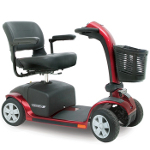 There are many different models of mobility scooters, but they can typically be classified as either a travel scooter, heavy duty scooter, or standard scooter.
There are many different models of mobility scooters, but they can typically be classified as either a travel scooter, heavy duty scooter, or standard scooter.
Heavy Duty Scooters are the most powerful and are designed to support more weight, as well as for outdoor use. As a result, they usually have reinforced bumpers, larger wheels, stronger suspension, and many other features. However, as they are much larger than other types of scooters, a heavy duty scooter usually requires scooter lift to transport the scooter away from home, as well as not being as well suited for tight quarter indoor use.
Travel Scooters are basically the direct opposite of a heavy duty scooter, with the focus being on making the scooter as lightweight as possible, so that it can be easily transported. This means they have fewer features and everything, from the tiller to the seat is designed to be as light as possible. A travel scooter can be taken apart easily and each individual piece is intended to be able to be easily lifted into a vehicle. Since a travel scooter is so light, they usually have the shortest per-charge range and a much lower weight capacity.
Standard scooters form the middle ground, trying to blend the right amount of features, with the overall weight of the device. As a result, they are not as easy to transport as a travel scooter, but have a larger range, more comfortable seating, and generally a number of comfort features. Usually they can be broken down into more manageable pieces, as can heavy duty scooters, but they are still much heavier than a travel scooter.
A Word About Wheels
Another way that mobility scooters are classified is by the number of wheels they have, specifically four wheel mobility scooters and three wheel mobility scooters. In the case of 4-Wheeled Scooters, there is a more even distribution of weight across the base of the scooter. This makes them more stable, as well as being better suited for larger weight capacities and outdoor use. For this reason, most heavy duty scooters are four wheeled.
Three wheeled scooters are not as stable, but they do have a smaller turning radius than four wheeled scooters. As a result, this makes them a better choice for indoor use. Also, since the front axle is smaller, they are also lighter, so many travel scooters use a three wheel design.
Electric Wheelchair Buyers Guide and FAQ
February 2nd, 2010
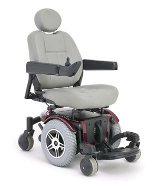 The wheelchair is one of the oldest known mobility aids, greatly improving the lives of those who have difficulty walking. There are many types of wheelchairs available, with sports wheelchairs becoming much more popular over the last ten years. However, for many the choice is whether to buy an electric wheelchair or a manual wheelchair, with both offering their own advantages.
The wheelchair is one of the oldest known mobility aids, greatly improving the lives of those who have difficulty walking. There are many types of wheelchairs available, with sports wheelchairs becoming much more popular over the last ten years. However, for many the choice is whether to buy an electric wheelchair or a manual wheelchair, with both offering their own advantages.
This guide provides the answers to some frequently asked questions about electric wheelchairs, which will help the consumer make an informed purchasing decision.
Electric wheelchairs, which are often called power chairs, are quite popular, but with so many choices and models available, it is important to understand how electric wheelchairs work and what their features are, before submitting to a high pressure sales pitch from your local medical supply store or online dealer.
Table of Contents
- What is an Electric Wheelchair?
- Electric Wheelchairs vs Manual Wheelchairs
- Where Can I Use An Electric Wheelchair?
- What is the Difference Between Mid-Wheel and Rear-Wheel Drive Power Chairs?
- How Are Power Chairs Controlled?
- Are There Any Alternate Control Systems Available for Power Chairs?
- How is the Chair Different Than a Manual Wheelchair?
- What Type of Range and Speed Should I Expect?
- How Do I Transport An Electric Wheelchair?
- What Are Travel Power Chairs?
- What Are Some Popular Power Chair Manufacturers?
What is an Electric Wheelchair?
An electric wheelchair is a motorized wheelchair that is powered using one or more rechargeable batteries. This allows the electric wheelchair, which is often referred to as a power chair, to be used easily away from the home, over both indoor and outdoor terrain.
The first electric wheelchairs, which were developed during the 1950′s, were simply manual wheelchairs that were outfitted with an electric motor, but today, they are custom made.
Electric Wheelchairs vs Manual Wheelchairs
Choosing between a manual wheelchair or an electric wheelchair is often a very personal decision, as they both offer advantages and disadvantages. In many cases, this comes down to personal preference, but there are several important things that should be considered when deciding whether to buy a power chair or a manual wheelchair.
The main advantage of an electric wheelchair is that it requires very little effort to use, while using a manual wheelchair is very strenuous. Where manual wheelchairs require that the user be pushed or self propel, with the latter requiring a great deal of upper-body strength, an electric wheelchair can be controlled with very little effort on the part of the user.
However, one disadvantage of electric wheelchairs is that they are much heavier and more difficult to transport than manual wheelchairs, which will be discussed later in the how do I transport an electric wheelchair section. Another consideration is that manual wheelchairs usually cost significantly less than power chairs.
Where Can I Use An Electric Wheelchair?
Like Mobility Scooters, electric wheelchairs are designed to be used both indoors and outdoors. However, they preform best over tightly packed surfaces. Due to their design, they are also not as well suited for outdoor travel as a mobility scooter is though, usually with a much shorter wheelbase and sometimes smaller wheels, making them work best over concrete or other hard surfaces.
However, unlike mobility scooters, an electric wheelchair can be driven directly up to a table or desk, in the same way that a manual wheelchair can.
What is the Difference Between Mid-Wheel and Rear-Wheel Drive Power Chairs?
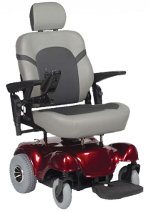 Rear-Wheel Drive Power Chairs typically have four wheels, which are spaced evenly apart from one another. The set of wheels in the back, the rear wheels, are what actually moves the power chair.
Rear-Wheel Drive Power Chairs typically have four wheels, which are spaced evenly apart from one another. The set of wheels in the back, the rear wheels, are what actually moves the power chair.
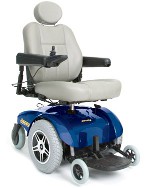 Mid-Wheel Drive Power Chairs, on the other hand, usually have three sets of wheels. The set of wheels in the middle is positioned directly under the seat and the front and back set of wheels are positioned about the same as those on a Rear-Wheel Drive chair. However, it is the middle set of wheels that moves the wheelchair, with the front and back set of wheels providing support and stability.
Mid-Wheel Drive Power Chairs, on the other hand, usually have three sets of wheels. The set of wheels in the middle is positioned directly under the seat and the front and back set of wheels are positioned about the same as those on a Rear-Wheel Drive chair. However, it is the middle set of wheels that moves the wheelchair, with the front and back set of wheels providing support and stability.
The main advantage of a mid-wheel drive wheelchair is that it is more maneuverable than a rear wheel drive wheelchair. Like manual wheelchairs, electric wheelchairs are steered by moving one wheel, while holding the other still. A Mid-Wheel Power Chair allows for a much smaller turning radius, as the turning axis is directly below the wheelchairs seat.
In contrast, a rear-wheel drive wheelchair turns from the back, as this is where the drive wheels are, which means it will have a higher turning radius. However, because the weight of the rider is more evenly distributed between the front and back of the wheelchair, a rear wheel drive wheelchair is typically more stable and better able to support larger weights. To counteract this, some mid-wheel drive wheelchairs are considerably larger and include support wheels that are positioned further from the frame than normal.
How Are Power Chairs Controlled?
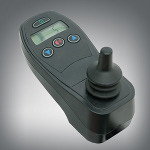 The basic control system that was first developed during the nineteen-fifties is still used today, with a joystick control being the standard control system for most electric wheelchairs. Of course, it is electronically based and made using much better technology, but the concept remains the same.
The basic control system that was first developed during the nineteen-fifties is still used today, with a joystick control being the standard control system for most electric wheelchairs. Of course, it is electronically based and made using much better technology, but the concept remains the same.
Typically, the joystick is mounted to the armrest on either side of the wheelchair, with most models also including simple throttle and horn controls as well.
Are There Any Alternate Control Systems Available for Power Chairs?
For those who are unable to use the traditional joystick control, a number of alternate wheelchair controls have been developed, with many of these having roots in the first wheelchair systems. Power chair control systems that allow the head to control the wheelchair are one of the more common, with several available that allow the wheelchair to be controlled by head movements.
Another popular option allows the users breath to control the movements of the wheelchair, with the user blowing through a small tube, similar to a straw, to move the wheelchair. There are also a number of experimental controls being developed, with one of the most promising allowing the user to control the wheelchair with their tongue, as it is common for movement of the tongue to remain, even in those who are otherwise paralyzed.
There are also a number of control systems developed with the caretaker in mind, which include remote control systems that allow the wheelchair to be controlled by someone walking behind it.
Also in development, there are several systems that allow the wheelchair to learn an environment, either by using GPS to map the environment or by manually adding map. This allows the wheelchair to navigate a room, building, or even campus, using proximity sensors to detect objects in the way. While still currently being developed, there are several live studies of these types of chairs, including one at a nursing home. Other potential controls, which could revolutionize wheelchair movements, include eye tracking software, which is able to detect where a user is looking.
How is the Chair Different Than a Manual Wheelchair?
The seat on most manual wheelchairs is made of vinyl, which is sewn around the frame of the wheelchair, although more breathable materials are also popular, especially on sports wheelchairs. However, the seat of an electric wheelchair more closely resembles a office chair. Some include a high back, with neck rest, while others have a much lower back, but they are typically made in a similar process, with a cushion built atop a hard flat board.
Depending on the model, some power chairs even have a reclining backrest and most allow the seat to be pivoted in both directions, making it easier to transport into and out of the chair.
If you buy a standard power chair, such as those made by Pride Mobility or Golden Technologies, there aren’t really too many options when it comes to the seat. However, special rehab seats are available, which include more supportive headrests, improved cushioning, and fully reclining seats. These power chairs also include individual leg rests that more closely resemble the leg rests used on a manual wheelchair, instead of the single platform that is usually provided for standard power chairs.
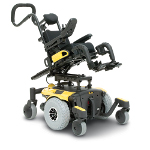 Pride Mobility’s Quantum Rehab division is one of the more well known offers of specialized power chairs, with bariatric and pediatric seats available that are mounted to one of their standard power chair bases. These seats also used a much more ergonomic cushioning that provides improved back support, as well as power tilt, which allows the seat to be reclined electronically.
Pride Mobility’s Quantum Rehab division is one of the more well known offers of specialized power chairs, with bariatric and pediatric seats available that are mounted to one of their standard power chair bases. These seats also used a much more ergonomic cushioning that provides improved back support, as well as power tilt, which allows the seat to be reclined electronically.
Back to Top
What Type of Range and Speed Should I Expect?
This varies depending on the model of scooter, as well as how it is used. However, most travel at speeds of between 3 and 4mph, with a range of around 15 miles.
One thing to keep in mind is that the range and speed is affected by the weight of the rider, as well as the terrain being traveled over. For example, if traveling uphill, the wheelchair’s battery will wear out faster and the chair itself will move slower than when traveling across flat ground.
Also, the battery will need to be replaced periodically, with the wheelchair loosing performance and range as the battery wears down.
How Do I Transport An Electric Wheelchair?
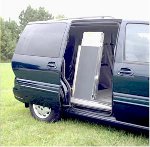 Electric wheelchairs are much heavier than manual wheelchairs and can not be folded up and placed in the trunk the same way you would with a self-propelled wheelchair. While most electric wheelchairs are designed to be taken apart, the individual pieces can be rather heavy and bulky. As a result, those who intend to use the wheelchair away from home, usually need to buy a wheelchair lift or a wheelchair ramp for their vehicle.
Electric wheelchairs are much heavier than manual wheelchairs and can not be folded up and placed in the trunk the same way you would with a self-propelled wheelchair. While most electric wheelchairs are designed to be taken apart, the individual pieces can be rather heavy and bulky. As a result, those who intend to use the wheelchair away from home, usually need to buy a wheelchair lift or a wheelchair ramp for their vehicle.
The least expensive option is the wheelchair ramp, with several foldable metal ramps available. These allow the wheelchair to be driven directly into a van, but do not work as well with other vehicles. Often, these ramps are not actually secured to the van itself, but there are also some van ramps available that are bolted to the floor of the van and can be folded down into place, making it much easier to use independently.
Wheelchair lifts are another option and offer much more flexibility, as they can be used on cars, trucks, SUVs, and Vans. Wheelchair lifts either act as a lifting platform, sort of like an elevator, or as a crane. They are also classified as either internal wheelchair lifts or external wheelchair lifts.
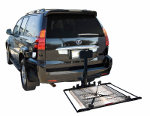 External Wheelchair Lifts are mounted to the hitch of a vehicle and typically store the wheelchair outside on the back end of the vehicle. However, there are several hitch mounted crane lifts that are used to move the wheelchair into inside of the vehicle.
External Wheelchair Lifts are mounted to the hitch of a vehicle and typically store the wheelchair outside on the back end of the vehicle. However, there are several hitch mounted crane lifts that are used to move the wheelchair into inside of the vehicle.
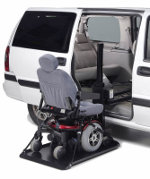 Internal Wheelchair Lifts, on the other hand, store the wheelchair on the inside of the vehicle. These work by either extending a platform from the vehicle onto the ground or by using the crane method. In vans, the platform lift works well when it is installed behind the drivers seat, with the mid row seating of the van removed. However, they can also be used on TRUCKS and SUVS. For passenger cars, a crane lift is usually the only option.
Internal Wheelchair Lifts, on the other hand, store the wheelchair on the inside of the vehicle. These work by either extending a platform from the vehicle onto the ground or by using the crane method. In vans, the platform lift works well when it is installed behind the drivers seat, with the mid row seating of the van removed. However, they can also be used on TRUCKS and SUVS. For passenger cars, a crane lift is usually the only option.
Wheelchair lifts are either powered by a rechargeable battery pack or by directly connecting to the vehicles battery. While wheelchair lifts that are connected to the vehicles battery are sometimes a little more complicated to set up, they end up being much lower maintenance, as you do not need to remember to charge the battery pack. Some wheelchair lifts also allow the wheelchairs charger to be plugged into it, so the wheelchair can be charged while on the road.
What Are Travel Power Chairs?
Travel Power Chairs are electric wheelchairs that are designed to be as lightweight as possible, which can make it easier to travel with them. They are usually designed to be taken apart easily, with the individual pieces being lighter and easier to manage. Also sometimes called portable power chairs, these wheelchairs can sometimes be transported without having to use a wheelchair lift.
However, this comes at the expense of features and range, as the wheelchair is stripped of as much weight as possible. This means a much smaller seat, with less padding, as well as a shorter range and weight capacity.
Folding Power Chairs are also available, which look similar to a manual wheelchair and can be folded in the same way. While these do take up less space than a standard power chair, they are still quite heavy, so are not often the best choice.
What Are Some Popular Power Chair Manufacturers?
Probably the most well known power chair manufactures are Pride Mobility and Golden Technologies, with both companies offering a number of popular and reliable electric wheelchairs. Pride’s Quantum Rehab line is also very popular, as they offer a number of wheelchairs with improved seating and controls, designed with rehab in mind.
While Pride Power Chairs and Golden Power Chairs are the most well known, there are many other manufacturers, with ShopRider Wheelchairs gaining popularity in the past few years by offering a lower price alternative.
When shopping for an electric wheelchair, however, it is important to not only focus on the price of the wheelchair and instead read reviews and consumer reports for each brand, while avoiding the many cheap no-name wheelchairs available. It is also important to make sure the company offers a comprehensive warranty.
The Development of the Modern Wheelchair
January 25th, 2010
 The wheelchair is one of the oldest types of home medical equipment, dating back thousands of years, with images depicting the use of carts and similar devices, used to transport those with limited mobility. However, if you looked at most of the early wheelchairs, you might not even recognize them as a wheelchair, nor where they something that was generally available to the regular population.
The wheelchair is one of the oldest types of home medical equipment, dating back thousands of years, with images depicting the use of carts and similar devices, used to transport those with limited mobility. However, if you looked at most of the early wheelchairs, you might not even recognize them as a wheelchair, nor where they something that was generally available to the regular population.
In the past, wheelchairs were traditionally only available to those such as nobility or who had the means to have one constructed. This is because there was no set standard to them, so instead the wheelchair had to basically be reinvented each time it was built, relying on the skills of the builder.
Towards the end of the nineteenth century, this began to change, with a semi-standard wicker wheelchair becoming much more common. This was in part due to the increased number of war veterans from the Civil War. These early wheelchairs where relatively inexpensive and featured a large wicker chair, which was often very high backed. Sometimes, however, wood was used in place of wicker, which was much sturdier, but also a great deal heavier.
While a big step up from the older models of wheelchairs, the wicker and wood wheelchairs were very cumbersome and could rarely be transported easily. They also usually required someone to push the wheelchairs, leaving the wheelchair user dependent on friends, nurses, or other caregivers to get around. These wheelchairs would remain common until the early 1930′s, when a much lighter wheelchair was developed.
The improved wheelchair, which was developed during the 1930′s was referred to as the E&J wheelchair, named for its inventors Everest and Jennings. What sets this apart from other wheelchairs was that it had a solid metal frame, constructed using hollow steel tubes. This provided a great deal of strength, but because the metal was hollow, it was not very heavy. The E&J wheelchair could also be folded up, making it much easier to transport in carriages and the less common automobile. In addition, the wheelchair featured large front wheels, allowing the wheelchair user to self propel, without the need to rely on a caretaker.
As was the case with the previous wheelchair design, much of the innovation and adoption was the result of injured veterans, this time from World War I. A few years later, World War II would begin and the E&J wheelchair would become the default wheelchair design.
By the 1950′s, the E&J wheelchair was still the most common choice of wheelchair, with inventors creating a electric wheelchair kit that could be used to convert a regular manual wheelchair to an electric one. These kits became very popular, with companies from Canada and New York developing quick converter kits.
Today, the E&J wheelchair design is still seen in most manual wheelchairs, with its lightweight hollow metal frame and folding design, making it a great choice for traveling. In fact, Everest and Jenning wheelchairs are still available, as the company has remained a powerful name in the wheelchair industry.
Mobility Scooter Buyers Guide and FAQ
January 18th, 2010
 Among the elderly, the mobility scooter provides one of the most valuable services for those who have difficulty walking. There are a number of different mobility scooter models available, as well as a number of different manufacturers, so it is sometimes overwhelming finding right mobility scooter, but when you know a little bit about them, it is not as difficult as it might seem.
Among the elderly, the mobility scooter provides one of the most valuable services for those who have difficulty walking. There are a number of different mobility scooter models available, as well as a number of different manufacturers, so it is sometimes overwhelming finding right mobility scooter, but when you know a little bit about them, it is not as difficult as it might seem.
Mobility scooters have been around for over forty years, but it was not until the eighties that they really became popular and more common place. Today, mobility scooters, which are sometimes called electric scooters or adult scooters, are very popular and provide a lower cost alternative to an electric wheelchair.
Below, you will find the answers to some frequently asked questions about these extremely useful senior mobility vehicles.
Table of Contents
- What Are Mobility Scooters?
- Where Can I Use My Mobility Scooter?
- What is the Difference Between Three Wheel vs Four Wheel Scooters?
- What Type of Speed and Battery Life Should I Expect?
- What Extra Features and Accessories Are Available?
- What Are Travel Scooters?
- What is a Heavy Duty Scooter?
- Who Are Some Popular Mobility Scooter Manufacturers?
What Are Mobility Scooters?
A mobility scooter is an electric vehicle that is used to carry a single occupant, typically both indoors and outdoors. They are similar to electric wheelchairs, except mobility scooters have a longer base, with the captain’s chair positioned more towards the rear of the scooter. A set of handlebars, called a tiller, is attached to the front of the scooter, which allows the scooter to be turned, as well as regulating speed, braking, and controlling the extra features, such as the horn and lights.
The main difference between a mobility scooter and an electric wheelchair is the addition of the tiller. Electric wheelchairs typically use a joystick control that is mounted to the side of the wheelchair’s arm rest, which allows the wheelchair to be driven directly up to a table or bench. Mobility scooters, on the other hand, are controlled by the tiller, which prevents it from being driven directly up to a table. Mobility scooters also usually cost a good deal less than electric wheelchairs.
Where Can I Use My Mobility Scooter?
Most mobility scooters are designed to be used indoors, as well as outdoors over tightly packed terrain. However, if you intend to use the scooter over loosely packed ground, such as dirt or sand, you may need to invest in a more durable mobility scooter. However, when driving over uneven terrain, even if it is tightly packed, it is important to be very careful in order to prevent the scooter from tipping over.
One thing to keep in mind is how much room you have indoors, as some mobility scooters are more maneuverable than others. The manufacturer will provide a turning radius, which describes the smallest space the scooter can turn it.
There are also environmental factors that can reduce the performance of the scooter. For example, driving a mobility scooter uphill will cause the battery to wear out quicker than when it is driven on flat terrain. Similarly, the weight of the rider also affect the per-charge range of the scooter, with a heavier rider reducing the range of the mobility scooter.
What is the Difference Between Three Wheel vs Four Wheel Scooters?
One way that mobility scooters are classified is by the number of wheels that they have, specifically, either three wheeled mobility scooters or four wheeled mobility scooters.
In general, a four wheeled mobility scooter will provide better stability and higher weight support, where a three wheeled mobility scooter will be more maneuverable. This is because the four wheeled scooter more evenly distributes the weight of the rider between the front and back of the scooter.
What Type of Speed and Battery Life Should I Expect?
Both the top speed and the per charge range, varies by model. However, most travel between 4-5mph and have a per charge range of between 8-10. There are, of course, exceptions to this, with some mobility scooters traveling over 10mph for distances of over twenty miles.
One thing to keep in mind when considering battery life, is that the amount you use the scooter will have a direct relation on how often you have to charge it and how long the battery lasts. For instance, someone that only uses their scooter once every few days probably would not need to charge the scooter everyday. On the other hand, someone who drives several miles each day on their scooter would probably have to charge it each night.
Environmental factors also play a part in battery life, with things like driving up hill or carrying extra weight causing the battery to wear down faster. Batteries do need to be replaced and depending on how much the scooter is used, this could mean replacing it each year or every few years.
What Extra Features and Accessories Are Available?
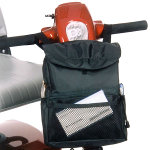 There are a number of extra features available for most scooters, which include things like cane holders, oxygen racks, and visibility flags. Often, some of these can be purchased cheaper at a bike store, as is the case with side mirrors and visibility flags, than you would be able to purchase them from a manufacturer. So, it is important to determine if it is a scooter specific accessory, which will only work with a specific model, or if it is an accessory that is generic, which will work with any type of scooter.
There are a number of extra features available for most scooters, which include things like cane holders, oxygen racks, and visibility flags. Often, some of these can be purchased cheaper at a bike store, as is the case with side mirrors and visibility flags, than you would be able to purchase them from a manufacturer. So, it is important to determine if it is a scooter specific accessory, which will only work with a specific model, or if it is an accessory that is generic, which will work with any type of scooter.
There are a number of bags that are also available, including armrest bags, under the seat bags, and back of the seat bags. Trays are also popular, which make it easier to eat, write, or work on a computer while using the scooter.
What Are Travel Scooters?
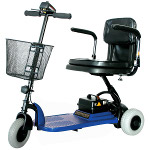 Travel scooters are lightweight mobility scooters that are designed so that they can be quickly and easily dissembled into several easy to manage pieces. Often, they use quick release snaps that can be activated with a single hand and the heaviest piece weighs only around 30 pounds.
Travel scooters are lightweight mobility scooters that are designed so that they can be quickly and easily dissembled into several easy to manage pieces. Often, they use quick release snaps that can be activated with a single hand and the heaviest piece weighs only around 30 pounds.
The advantage of a travel scooter is that it can be stored quickly and easily in a plane, car, or other vehicle, without having to use a scooter lift. Most travel scooters are three wheeled, as this helps reduce weight. However, they are also usually bare bones in regards to included features, which helps to reduce weight. Travel scooters are also not able to travel as far on a single charge, nor are they able to support as much weight or preform as well outdoors as other mobility scooters.
What is a Heavy Duty Scooter?
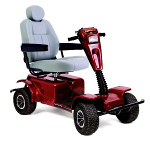 A Heavy Duty Scooter is one that is designed to support more weight and preform better outdoors than a regular mobility scooter. They typically are four wheeled, which provides the most stability and use air filled, pneumatic, tires, which improve suspension and off road performance. Heavy Duty Scooters are intended for outdoor use, so have larger wheels and a higher ground clearance, as well as having reinforced bumpers, extra large seats, and a number of other extra features.
A Heavy Duty Scooter is one that is designed to support more weight and preform better outdoors than a regular mobility scooter. They typically are four wheeled, which provides the most stability and use air filled, pneumatic, tires, which improve suspension and off road performance. Heavy Duty Scooters are intended for outdoor use, so have larger wheels and a higher ground clearance, as well as having reinforced bumpers, extra large seats, and a number of other extra features.
While Heavy Duty Mobility Scooters are well suited for outdoor use, have a very large range, and a much higher weight capacity than other scooters, they are much bigger than most other types of scooters. As a result, a heavy duty scooter might not work well inside of a smaller home and to transport it, a scooter lift would be needed.
Who Are Some Popular Mobility Scooter Manufacturers?
There are a number of mobility scooter manufacturers, but Pride Mobility and Golden Technologies are probably the most well known, with both companies having manufactured home medical equipment for over twenty years. While Pride Scooters and Golden Scooters are the most recognized, they also tend to cost more than other lesser known brands.
ShopRider is a company that offers a number of mobility scooters, which are typically priced lower than Golden Mobility Scooters and Pride Mobility Scooters.
Ultimately, if you decide not to go with one of the major brands, it is important to check for consumer reviews of the company and their scooters. Also, ensure that they provide a warranty for their scooter, which is similar to the length of a warranty on a name brand scooter. There are a number of very cheap scooters out there, but they will often have a very limited warranty, which means they should usually be avoided.
What Are Heavy Duty Mobility Scooters?
January 11th, 2010
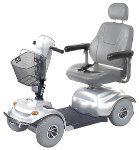 Mobility Scooters are often used by seniors and are electric scooters designed to help make it easier to get around. Using rechargeable batteries, these adult scooters can be driven indoors and outdoors, making life easier for who are able to walk, but only with difficulty. There are many types of mobility scooters, but one of the most powerful and fun to drive types is the Heavy Duty Mobility Scooter.
Mobility Scooters are often used by seniors and are electric scooters designed to help make it easier to get around. Using rechargeable batteries, these adult scooters can be driven indoors and outdoors, making life easier for who are able to walk, but only with difficulty. There are many types of mobility scooters, but one of the most powerful and fun to drive types is the Heavy Duty Mobility Scooter.
As the name implies, a Heavy Duty Mobility Scooter is very rugged, has a heavier weight capacity, and can be driven in areas where other types of mobility scooters could not. They have larger wheels and often reinforced shocks, making them well suited for off road terrain. It is also common for heavy duty mobility scooters to have reinforced bumpers, to protect against impacts and things like brush, which might be experienced when driving the scooter outdoors.
Pneumatic Tires are also almost always used, which means the tires are filled with air instead of being a solid piece of rubber. This helps to improve traction, making the scooters preform better on loosely packed dirt or other outdoor terrain.
Most Heavy Duty Scooters use a four wheel design, as this provides the most stability, but some three wheeled heavy duty scooters are available. The Three Wheel Models will have a better turning radius, at the expense of reduced stability.
To give you an idea of the difference in weight capacity between a regular mobility scooter and a heavy duty mobility scooter, most regular adult scooters support between 250 and 300 pounds. A heavy duty scooter, on the other hand, will usually support between 400 and 500 pounds.
Not only are heavy duty scooters able to support more weight than other electric scooters, they also have a significantly higher top speed and battery life. For example, it is common for a heavy duty scooter to travel more than 25 miles on a single charge at speeds over 5 mph. This is opposed to most traditional electric scooters, which have a range of around 10 miles or less.
Heavy Duty Electric Scooters also have a number of extra features to make them more comfortable, such as improved seats with head support and even sometimes carpeting on the base of the scooter.
Disadvantages of Heavy Duty Mobility Scooters
One thing to keep in mind is that Heavy Duty Mobility Scooters are usually the most expensive type of mobility scooter. They usually start at around $2500 and can exceed $5000, depending on the model and features.
Also, since heavy duty mobility scooters are so much larger and heavier they are not as easy to transport. Most of those who purchase a heavy duty mobility scooter invest in a scooter lift for their vehicle, which makes it easier to transport.
Heavy Duty Scooters also are not as maneuverable as other smaller electric scooters, so will not always be the best choice for use indoors.
Popular Heavy Duty Mobility Scooter Manufacturers and Models
Pride Mobility, Golden Technologies, and ShopRider all offer at least one Heavy Duty Mobility Scooter.
There are several different models of heavy duty scooters, but the ShopRider Xl4 Deluxe(#889XLSBN,) Golden Avenger(#GC-541,) and Pride Hurricane(#PMV5001) are some of the more popular models of heavy duty scooters.
Manual Wheelchairs vs Electric Wheelchairs: A Buyers Guide
January 4th, 2010
Wheelchairs are important safety tools that are used by those who are unable to walk or have difficulty doing so. While the wheelchair has roots that date back thousands of years, modern wheelchairs are based off of a hollow steel tube design that was developed during the 1930′s. This design remains popular today and helps keep the weight of the wheelchair down, without sacrificing its strength.
While the folding steel tube manual wheelchair is still very common, many wheelchair users prefer electric wheelchairs. Electric wheelchairs offer the same basic functionality that manual wheelchairs offer, except they are operated electronically. Electric wheelchairs also have a design that is much different than a manual wheelchair is.
How Manual Wheelchairs are Designed
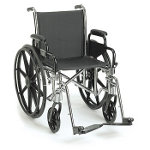 A manual wheelchair usually has a wide chair, with two large wheels on either side and two small wheels in front. The larger wheels have handrails that extend off of the wheel and allow the user to move the wheels, without having to actually touch that part f the wheel that makes contact with the ground.
A manual wheelchair usually has a wide chair, with two large wheels on either side and two small wheels in front. The larger wheels have handrails that extend off of the wheel and allow the user to move the wheels, without having to actually touch that part f the wheel that makes contact with the ground.
Many manual wheelchairs also have push handles that extend backwards from the top of the chairs seat, allowing someone to push the wheelchair from behind.
While most manual wheelchairs are designed to be self-propelled, which is why they have the larger rear wheels, some wheelchairs are only designed to be pushed. These wheelchairs, which are sometimes called transfer wheelchairs or transport wheelchairs, have much smaller wheels.
Sports wheelchairs are also very popular and come in a variety of designs. Some, like those used during wheelchair basketball or wheelchair rugby, are very specialized. For example, since wheelchair basketball can be so dangerous, a wheelchair basketball sports wheelchair will have a guard around the entire wheelchair. Another example of a specialized sports wheelchair is those used for wheelchair racing, which have a much longer wheelbase than other wheelchairs.
Other sports wheelchairs offer a much less specialized design, with a focus more on being lightweight and small, while allowing for optimal turning and speed. These are a popular choice by many wheelchair users, even those who do not actually play wheelchair sports.
How Electric Wheelchairs Are Designed?
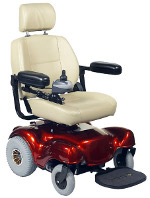 Electric Wheelchairs, on the other hand, are not intended to be self-propelled and are instead operated using a rechargeable battery. As a result, they only have a limited range before the battery must be recharged.
Electric Wheelchairs, on the other hand, are not intended to be self-propelled and are instead operated using a rechargeable battery. As a result, they only have a limited range before the battery must be recharged.
The weight of the rider as well as what type of terrain is driven over can affect the wheelchairs per-charge range. So, for example, driving up hill will wear the battery out quicker than driving it on level ground. With that said, many have ranges that are over 8 miles per charge, which is a fairly large distance for most people.
Unlike manual wheelchairs, the wheelbase of an electric wheelchair is very small. Some have four small wheels, with the rear wheels being responsible for actually moving the wheelchair. Other power chairs use a mid-wheel drive system, with a set of wheels in the front and back that provide support, while the set of wheels in the middle are responsible for moving the chair. Usually a mid-wheel drive power chair is much more maneuverable than a rear-wheel drive power chair.
Atop of the plastic base of the power chair, a captains chair is installed. Usually the captains chair is designed similarly to an office chair. The armrests can be folded up and the actual control system is placed on either the right or left armrest. The chair can also be pivoted to make it easier to enter and exit the wheelchair.
Like office chairs, the style of the captains chair varies depending on the model of the electric wheelchair. For instance, some will have a much higher back with head and neck support, while others have a considerably lower back without any neck support.
What is Best For Me?
Often, choosing between a power chair or a manual wheelchair comes down to personal preference. For instance, many prefer the physical effort that is required to use a manual wheelchair, while others find that it is too strenuous.
Cost is also a factor, as you can usually find a quality manual wheelchair for less than $500, while an electric wheelchair usually starts at $1500 and goes up from there.
It is also important to consider where you will be using the wheelchair, as if you are only planning on using it around the home, an electric wheelchair could be overkill. On the other hand, someone going to school and traveling across campus daily might prefer an electric wheelchair.
Transporting the wheelchair is another concern. Most manual wheelchairs are designed to be folded when not in use. This allows them to be stored in the trunk of a car or even the backseat with little difficulty. Electric wheelchairs, on the other hand, are considerably heavier and will often require some sort of wheelchair lift is installed onto the automobile.
Another consideration is that a Manual Wheelchair will almost always work, providing it is regularly maintenance. An electric wheelchair is more prone to mechanical or electrical failure, as well as being more sensitive to rain and other elements. As a result, a manual wheelchair often provides a much more long term and dependable option, without the need for replacing batteries or other maintenance that is required on a power chair.